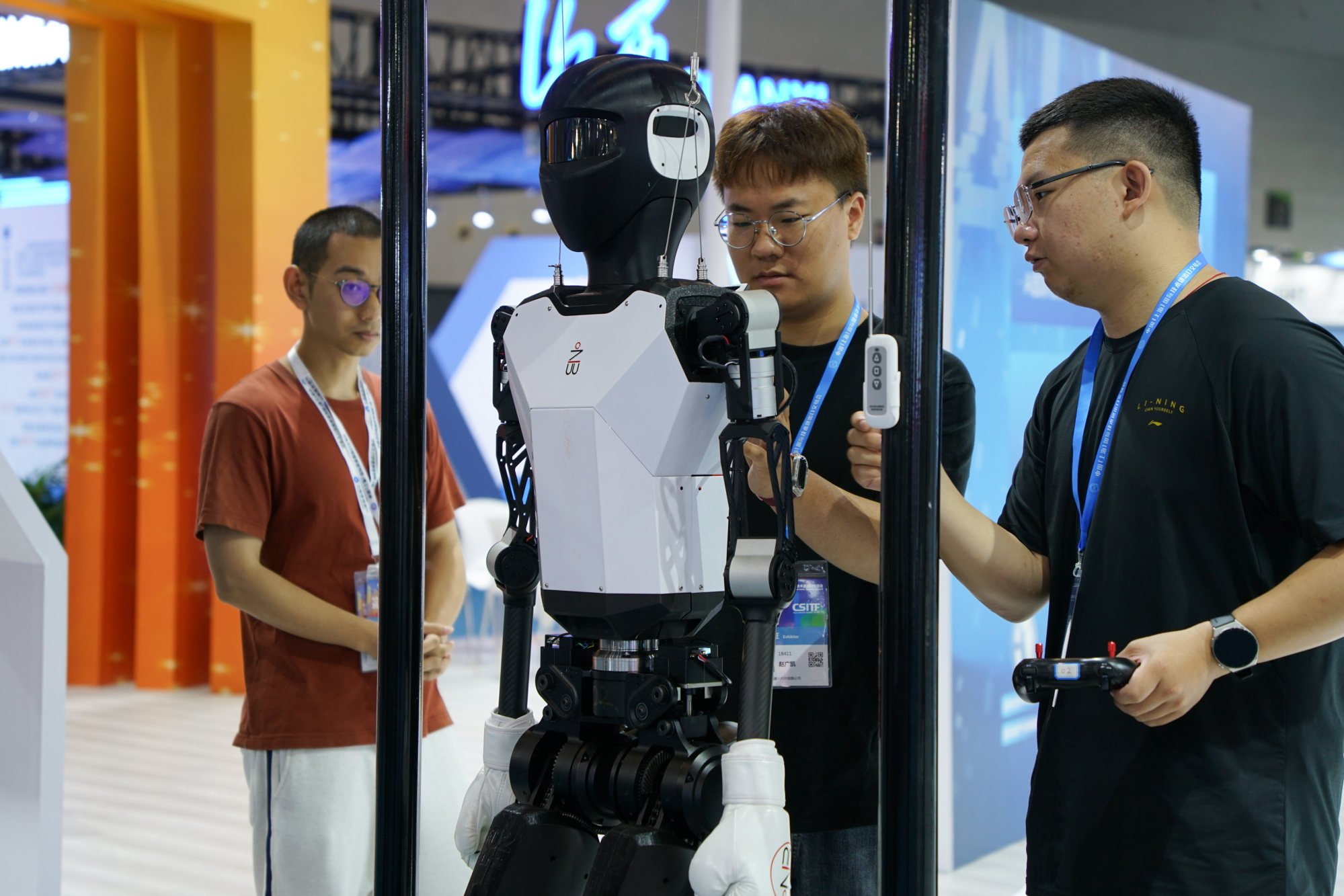Wandering around an exhibition hall at a tech fair in Shanghai, a humanoid robot took small steps for robotkind. And while still unable to leap itself, its presence nonetheless illustrated strides in China’s robotics industry.
It appears a little clumsy at first glance – unlike the anthropomorphically perfected androids seen in sci-fi – but the 25kg (55-pound) device features full-body controls and 30 degrees of movement freedom. It can also grasp objects and is capable of conversing in sign language.
Zhang Yongwen, CEO of the robot’s nascent manufacturer, Fairyon Humanoid Tech, sees the company’s future mainly in the homes of elderly people – offering them much-needed assistance and companionship.
“We’re also developing a new type that can make facial expressions that closely resemble humans, such as smiling and blinking,” he said, speaking at last month’s China (Shanghai) International Technology Fair, where his robot turned heads while roaming the floor.
Established early this year in Shanghai, Zhang’s company is among the humanoid robot developers that have multiplied in China in recent years as the country has set its sights on technological innovations and high-end manufacturing amid an intensifying trade and tech rivalry with the United States.
Human-like robots, which can be highly versatile when using tools created by humans and can respond to human emotions, are expected to help make up for a diminishing demographic dividend that the country once enjoyed, and to plug the gap in elderly care as Chinese society rapidly ages and its workforce shrinks, according to industry insiders.
A new high ground in the global scientific and technological competition, the humanoid robot sector in China entered a period of “explosive growth” last year, seeing an industry size of 3.91 billion yuan (US$539 million), or 85.7 per cent larger than the year prior, according to a report issued in April by a government-backed think tank, the China Centre for Information Industry Development.
It projected that China’s industry will continue to grow rapidly and expects it to be valued at more than 20 billion yuan by 2026.
Globally, the market for artificial beings will see an average growth rate of 70 per cent per year through 2035, leading to a global market size of US$38 billion, according to a Goldman Sachs research note in January.
Carmaker Tesla could start selling its high-profile humanoid robot, Optimus, which is still in development, by the end of next year, CEO Elon Musk said at the company’s annual shareholder meeting last month.
And as many as “a few thousand” units could be working in the company’s factories by 2025, he added.
Zhang, the Shanghai CEO, said: “As China’s population ageing deepens, robots are taking up a big amount of labour left by a smaller workforce and are becoming an important driver of new economic growth.”
Dividends of a young and increasing population are widely believed to be an important pillar for China’s quick economic rise over the past decades, but a rapid demographic shift is expected to put downward pressure on the labour supply and economic growth of the world’s second-largest economy over the coming decades.
China’s population fell by 2.08 million in 2023 to 1.4097 billion, a year after reporting the nation’s first population decrease in six decades, according to figures from the National Bureau of Statistics.
The proportion of those aged 65 and above also rose from 9.7 per cent in 2013 to 15.4 per cent in 2023, data showed.
As labour costs rise in a greying society, humanoid robots, which can be efficient helpers in workplaces and at home, are also helping businesses cut costs and produce more standardised goods, said Qiu Yufeng, co-founder of Hangzhou-based robot company Zopia Robot.
“Though we’re a global leader in the application of industrial robots, these machines are still unable to do a lot of work like humans do, such as telling products apart by their size, shape and rigidity,” he said.
“Because most of the tools we use are designed based on human characteristics, the most convenient way to replace human labour is to create humanlike robots,” he explained.
The artificial intelligence (AI) craze has been a “major breakthrough” in robotics, as embedding the technology makes them more similar to humans and able to work in different scenarios and various fields, he added.
In comparison, traditional robots are mostly task-specific – a welding robot can only weld, and a stacking bot can merely pile up products.
But there is also a question of whether humanoids are necessarily needed when specialised robots may be able to execute routines much more efficiently, unencumbered by the restrictions of the human form.
Those machines … can interact with elderly people, offering emotional support and companionship
In 2022, China installed 290,258 industrial robot units, accounting for more than half of the 553,052 industrial robot installations recorded in factories worldwide, according to a report from the International Federation of Robotics.
The mass production of robots boasting AI brains and humanlike bodies is a goal that the Ministry of Industry and Information Technology vowed to realise by 2025, according to an ambitious blueprint document issued in November.
Calling them as “disruptive” as electric cars, smartphones and personal computers, the ministry also pledged that by 2027, China will have reached an advanced level in terms of its overall capacity to make the product.
Besides addressing a shortage of skilled workers, the value of humanoid robots to an ageing China also lies in the potentially substantial changes that the technology brings to elderly care, Qiu said.
“It’s particularly meaningful to long-term care, as those machines are anthropomorphic and can interact with elderly people, offering emotional support and companionship, plus other assistance,” he said. “Compared with human nannies, who are expensive and could abuse seniors … robots will not have these problems and can be used for at least 10 years.”
While the adoption of AI-powered robots is expected to push some human workers out of their jobs, it is not going to worsen youth unemployment – an issue that China has struggled to tackle as it enlarges enrolment in tertiary education, said Leon Liang, a sales engineer with robotics maker Siasun.
“College graduates can’t find jobs not because there are no opportunities, but because they don’t want to be skilled workers at factories,” he said.

As more young Chinese pursue higher degrees and stable office work, businesses are having difficulty recruiting blue-collar workers – and those jobs being increasingly done by robots, he noted.
“Some companies offered a competitive monthly salary of 10,000 yuan for a welder but simply can’t find a qualified one,” he said.
In comparison, the average monthly salary expectation among the class of 2024 is 8,033 yuan (US$1,100), according to a report released in October by Chinese recruitment platform Liepin, based on information from the résumés it had collected.
Compared with the government’s ambitions for a quickly maturing humanoid robot industry, Liang was tempering his expectations, noting that the goals will require “a lot of patience and money, though everyone is swarming the sector”.
Most of the humanlike robots made in China so far are being bought by research institutes for further development, said Qian Yuqi, a marketing manager from Unitree Robotics in Hangzhou.
Her company is already mass producing a 1.8-metre-tall, two-legged robot it launched last year and is selling units mostly to carmakers, she said, declining to discuss specifics.
Nio, one of China’s major electric car makers, has been running tests this year to optimise the use of humanoid robots at its manufacturing base in Hefei, Anhui province. “They still need a lot of training,” a staff worker told the media during a factory tour in late June.
Over the past decade, China has gone “from lagging behind to catching up and ultimately leading in humanoid-robot-technology patents”, with its world-leading number of humanoid-robot-patent applications and number of valid patents, according to a report in December from a research institute under the People’s Daily party mouthpiece.
However, what’s more important is the number of core patents, which China still lacks, said Qiu from Zopia.
“It doesn’t work if we have numerous patents but not enough core ones. I would say we’re getting closer to the US in this regard,” he said.
He added that he believed China was not far from its goal of mass-producing humanoid robots by 2025, as businesses flourish in the field.
“The domestic supply chain is still not complete, at present, but as businesses keep learning and integrating resources, it is quite likely to be built within a couple of years,” he said. “Time is pressing, though.”



